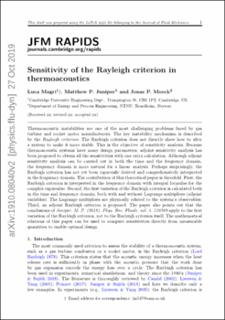| dc.contributor.author | Magri, Luca | |
| dc.contributor.author | Juniper, Matthew | |
| dc.contributor.author | Moeck, Jonas | |
| dc.date.accessioned | 2021-03-15T09:24:22Z | |
| dc.date.available | 2021-03-15T09:24:22Z | |
| dc.date.created | 2019-11-08T16:22:11Z | |
| dc.date.issued | 2020 | |
| dc.identifier.citation | Journal of Fluid Mechanics. 2020, 882 R1-1-R1-12. | en_US |
| dc.identifier.issn | 0022-1120 | |
| dc.identifier.uri | https://hdl.handle.net/11250/2733321 | |
| dc.description.abstract | Thermoacoustic instabilities are one of the most challenging problems faced by gas turbine and rocket motor manufacturers. The key instability mechanism is described by the Rayleigh criterion. The Rayleigh criterion does not directly show how to alter a system to make it more stable. This is the objective of sensitivity analysis. Because thermoacoustic systems have many design parameters, adjoint sensitivity analysis has been proposed to obtain all the sensitivities with one extra calculation. Although adjoint sensitivity analysis can be carried out in both the time and the frequency domain, the frequency domain is more natural for a linear analysis. Perhaps surprisingly, the Rayleigh criterion has not yet been rigorously derived and comprehensively interpreted in the frequency domain. The contribution of this theoretical paper is threefold. First, the Rayleigh criterion is interpreted in the frequency domain with integral formulae for the complex eigenvalue. Second, the first variation of the Rayleigh criterion is calculated both in the time and frequency domain, both with and without Lagrange multipliers (adjoint variables). The Lagrange multipliers are physically related to the system’s observables. Third, an adjoint Rayleigh criterion is proposed. The paper also points out that the conclusions of Juniper (Phys. Rev. Fluids, vol. 3, 2018, 110509) apply to the first variation of the Rayleigh criterion, not to the Rayleigh criterion itself. The mathematical relations of this paper can be used to compute sensitivities directly from measurable quantities to enable optimal design. | en_US |
| dc.language.iso | eng | en_US |
| dc.publisher | Cambridge University Press | en_US |
| dc.rights | Attribution-NonCommercial-NoDerivatives 4.0 Internasjonal | * |
| dc.rights.uri | http://creativecommons.org/licenses/by-nc-nd/4.0/deed.no | * |
| dc.title | Sensitivity of the Rayleigh criterion in thermoacoustics | en_US |
| dc.type | Peer reviewed | en_US |
| dc.type | Journal article | en_US |
| dc.description.version | acceptedVersion | en_US |
| dc.source.pagenumber | R1-1-R1-12 | en_US |
| dc.source.volume | 882 | en_US |
| dc.source.journal | Journal of Fluid Mechanics | en_US |
| dc.identifier.doi | 10.1017/jfm.2019.860 | |
| dc.identifier.cristin | 1745487 | |
| dc.description.localcode | © 2020. This is the authors’ accepted and refereed manuscript to the article. This manuscript version is made available under the CC-BY-NC-ND 4.0 license http://creativecommons.org/licenses/by-nc-nd/4.0 | en_US |
| cristin.ispublished | true | |
| cristin.fulltext | postprint | |
| cristin.qualitycode | 2 | |

